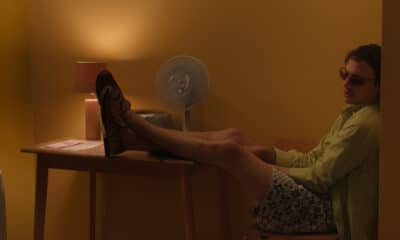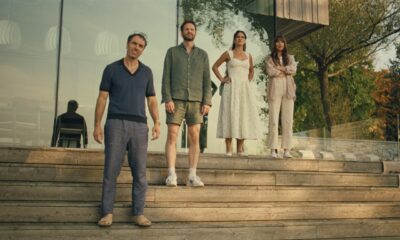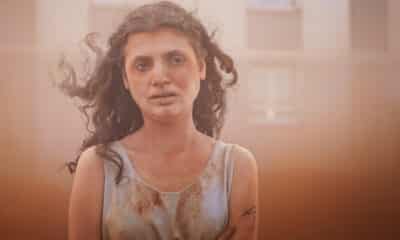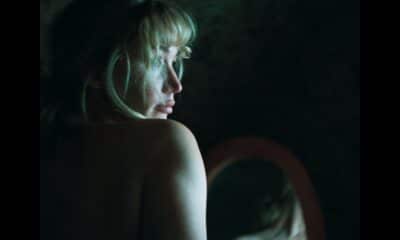Yesterday at Pigeon Shrine FrightFest, Konstantinos Koutsoliotas debuted the European premiere of his new film, Minore. The movie sees a Greek seaport invaded by strange aquatic creatures. We caught it ahead of the screening and were won over by its silly heart, entertaining characters, and face-melting special effects. It screens again at the festival on Monday 28th August, so if you missed the first screening you might be able to squeeze into the second.
Ahead of the FrightFest screening we spoke with both Koutsoliotas and his co-writer Elizabeth E. Schuch (writer and director of the fantastic Book of Birdie) to find out more about the project. Our interview covered the origins of the idea, a brief history of Greek cinema, the importance of effects work, and Koutsoliotas’ deep-seated fear of tentacles…
Minore has a wild story, how did the idea come to you?
Elizabeth E. Schuch: We were showing our very first zero budget, Greek language film, we’d shot in his parents haunted house in a mountain in Greece. We’re showing it at the Thessaloniki Festival, which is a beautiful festival. It’s on a bay, and we’re looking out at this gorgeous bay and very excited about what we’re going to do next, and the idea of a monster…and he loves Lovecraft so much. So the idea of some giant sea monster coming out of the bay just struck us and we thought that would be amazing. Just to see that in a Greek setting and then what would happen in Greece specifically. If a monster invaded, would the government come, would people fight it, would it be your granny leading the brigade…?
Konstantinos Koutsoliotas: You would basically be left alone to die basically.
ES: Who would be fighting? There were beautiful neoclassical abandoned hotels nearby. The whole setting of the festival actually inspired us.
KK: And we both like B-movies so we were making something that’s really fun to watch. Because we had kind of full control over the creative thing, taking it as far as we wanted.
ES: We wrote the weirdest script we could think of.
KK: And we both work in visual effects (Prokopis Vlaseros) in our day jobs and you do tend to work, especially on bigger budget films in formula. You have this happen in the first ten minutes. This happens in the first twenty. So it was a little bit fun and exciting basically for us. I hope it translates to the English public.It’s a very Greek story.
ES: There’s a tradition in Greece, where you have a say, from the 60s, and you start the plot of the movie. And, even if it’s a really depressing drama about a boat accident, you’re going to stop and dance at some point quite seriously. So that was a special flavour we wanted to add.
KK: It’s an homage to the type of movies I grew up with. I grew up with this movie style because people were quite poor back then, you didn’t have money to go out and experience a day out. They would just go to a tavern or something. So you would watch a full number of them playing, and you just watched the like as an audience member. That was a way of taking the normal people on a day out. It’s an homage to this kind and all Greek movies as well. It’s pretty stylised, trying to mix the old Greek movies with B-movies with Hammer.
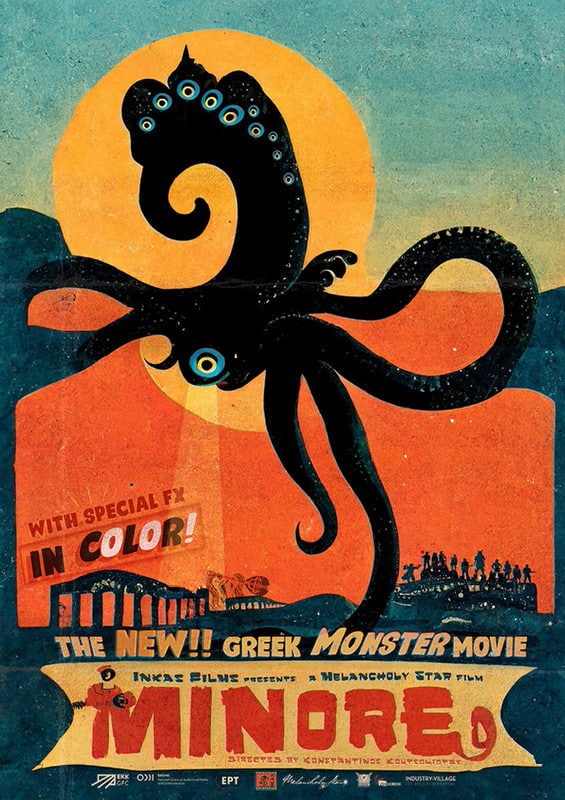
Although the film eventually gets very action-packed, initially it keeps its more monstrous components hidden, why did you decide to keep them back for so long?
KK: Personally, I love the interactions between the people more. That’s more of the fun for me, getting to know your people. Again, my normal job is just throwing CGI things to save the movie basically. And we didn’t want to do that. We kind of want to have CGI there, but it’s more about the people in how their faces react to seeing something. It’s all about the reaction of the people, that’s where the fun is. The monster for me, was like a hark back to Ray Harryhausen, but taking it into what we can do. In Greece, you think of bright sunlight. So, what’s the closest thing to bright sunlight? You know, like the old Titan movies. So it’s kind of trying to bring that look in there and see how that would work, but it had to be funny and B-movie-like as well. For me, if the creatures were really scary and horrific-looking, you lose the comedy side of things. So trying to balance everything…
ES:..but make it realistic. Obviously, it’s a huge risk, especially with how attention spans swing these days, to really spend that time with the characters. But honestly, you’re not going to get quite to that show down at the church until you go and have some dinner at Granny’s first and maybe do one or two other things on the way. Which for me as a stranger in Greece, feels like a very common experience.
KK: Also it’s actually, I wouldn’t say dangerous, but, in Greece, you never shoot inside the church and we’ve done that. It’s some ground that’s a little… I don’t know how we are going to do in Greece.
The design of creatures is brilliant, was there anything that inspired their appearance? Maybe a heavy night on the cheese?
ES: You clearly have been researching us well if you knew it was cheese. We’ve always loved lasers since [Book of] Birdie.
KK: In the Mediterranean we have this thing similar to the Evil Eye.
ES: A lot of cultures have it. If you look in Turkish kebab shops in Britain, the little blue eye, the glass eye hanging everywhere…
KK: I grew up with stories of my Granny saying “oh be careful of this other old granny. She has the Evil Eye.She can make a donkey die just by looking at it.” I thought, what if we mix this with Lovecraft with the Evil Eye and tentacles.
ES: Everybody fears the Evil Eye quite a lot, so putting that as a manifest creature just seemed like really, really fun and cheeky.
KK: Also I thought it looked quite silly as well, so you wouldn’t take it so seriously. You understand the genre we’re going for.
ES: Also, we don’t know why Konstantinos has this thing about, lots and lots of tentacles on a creature.
KK: Childhood trauma.
ES: I don’t know if an octopus attacked him. He doesn’t talk about it.
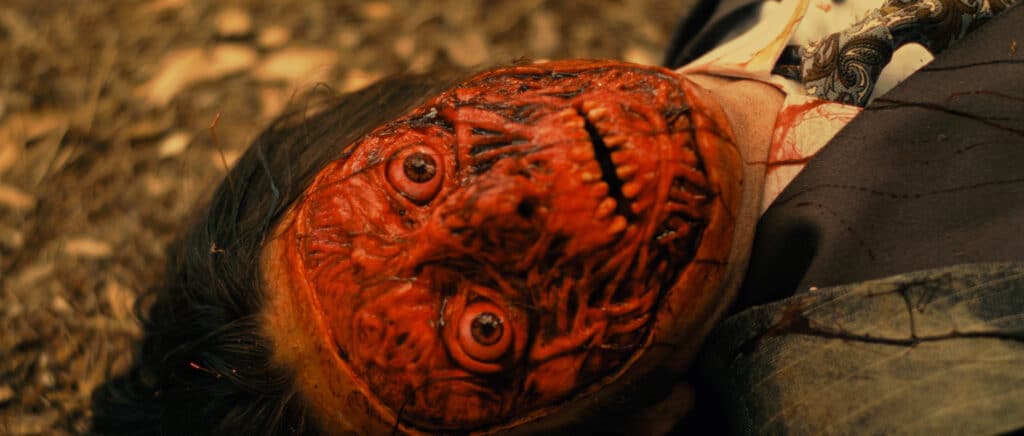
There is a long standing debate of VFX vs practical. Here you utilise both, do you think it’s time the industry got over this way of thinking and started to think about marrying them together more?
KK: It’s exactly what you’re saying. It is not one or the other. Especially with the new kind of movies coming out, it’s “oh the visual effects are bad.” Every movie right now has visual effects whether you notice it or not. The good thing for me is when the filmmaker tries to think about both of them before they shoot. Then you don’t end up coming to post-production saying, “okay, we’ll save it with visual effects,” and then you start from zero.
ES: It’s about being intentional with what you use. It’s always great to have something practical on the screen to start with, like that bucket of slime on the actor. So they really have slime on them and then you’re bringing it in something. Something practical always helps. In some cases it’s physically impossible, but if you can ground it in something, it’s going to look so much more fun.
KK: Of course, there’s always how much budget you have to factor in. If you have the budget, you can make something wonderful like [Guillermo] del Toro movies that are art both in visual effects and special effects. You see the set design, Liz is the set design and storyboard artist. We both appreciate the beauty behind really good art. But then when you have a twenty-five day shoot…
ES: We would have loved to have even more practical. We threw as much of the budget at it as we could, because it was important to us that it be there.
What do you hope audiences experience when watching Minore?
Both: Fun!
ES: We hope they have fun, a nice night at the cinema with popcorn.
KK: There are a few meanings blended into there if you want to go deeper. But for me, after Covid, we just wanted to make something that was just pure fun. The type of summer movie you would go and watch as a teenager and have fun and throw things at the screen.
ES: Greece has a wonderful tradition of summer outdoor cinema, so he grew up watching movies by the sea, outside. So I think that was the feeling we had in mind; it’s something to watch by the seaside with popcorn.
Minore screened at Pigeon Screen FrightFest 2023.
Kat Hughes is a UK born film critic and interviewer who has a passion for horror films. An editor for THN, Kat is also a Rotten Tomatoes Approved Critic. She has bylines with Dread Central, Arrow Video, Film Stories, and Certified Forgotten and has had essays published in home entertainment releases by Vinegar Syndrome, Arrow and Second Sight. When not writing about horror, Kat hosts micro podcast Movies with Mummy along with her six-year-old daughter.

Latest Posts
-
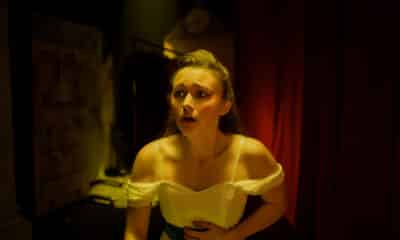

Film Reviews
/ 6 hours ago‘Fear Street: Prom Queen’ review: Dir. Matt Palmer (2025)
It has been four years since Leigh Janiak’s Fear Street trilogy took horror fans...
By Kat Hughes -
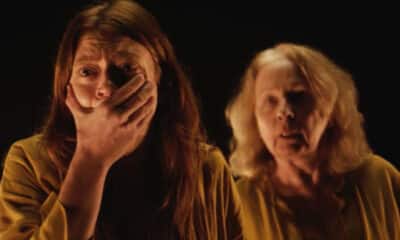

Film Reviews
/ 7 hours ago‘The Surrender’ review: Dir. Julia Max (2025)
As Julia Max’s debut feature, The Surrender, unfolds, the inspirations for the film become...
By Kat Hughes -
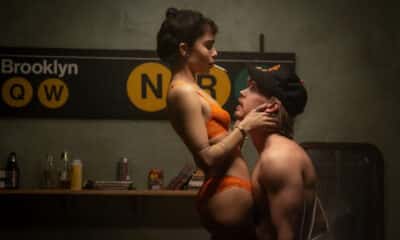

Film Trailers
/ 2 days agoFirst trailer for Darren Aronofsky’s ‘Caught Stealing’
Sony Pictures has released the debut trailer for Darren Aronofsky’s new film Caught Stealing,...
By Paul Heath -


Film Reviews
/ 3 days ago‘Lilo and Stitch’ review: Dir. Dean Fleischer Camp (2025)
Director Dean Fleischer Camp won audiences over with the fantastic Marcel the Shell with...
By Kat Hughes
